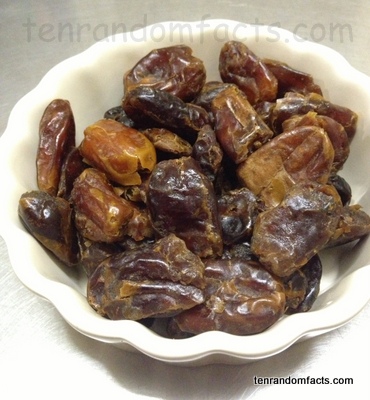Sugary juicy dates.
- Dates are a small fruit of the date palm tree, Phoenix dactylifera and are said to be native to Northern Africa and the Middle East.
- Dates range from red, yellow and brown in colour and grow to 2.5 – 7 cm (1 – 2.7 inches) in length and have a large seed inside which is often removed, and this is called a pitted date.
- Dates have been eaten for thousands of years, and are referred to in the Christian Bible.
- Dates contain up to 85% sugar, and contain many vitamins and minerals, including significant amounts of potassium, Vitamin B, magnesium and manganese.
- One date palm can produce 80 to 120kg (176 to 264 pounds) of dates each year, although younger plants do not produce as many.
- Dates have four different stages of ripening, known as kimri (unripe), khalal or khalaal (crunchy), rutab (soft), tamr or tamar (chewy) and are eaten at the khalal, rutab and tamr stages.
- In 2009, Egypt, Saudi Arabia and Iran produced about 3.5 million tonnes (3.9 million tons) of dates out of the worldwide production of over 7.4 million tonnes (8 million tons).
- Dates can be eaten raw, dried, softened, stuffed with nuts or other items, made into a paste, used in desserts or savoury meals, stored in the freezer for use at a later date, and when dried they can be kept almost indefinitely because of their high sugar content.
- There are three main varieties of dates grown: ‘soft’, when the date skin is soft, the date is moist and has lower sugar content; ‘semi-dry’, when the date skin is firm, not very moist and high sugar content; and lastly ‘dry’ when the date skin is leathery and the date has barely any moisture and has high sugar content.
- Dates are said to assist the growth of good intestinal bacteria and are a great food to eat when hungry or commonly used when breaking a fast due to the sugar content which quickly re-energises the body.





